flat tire TOYOTA C-HR 2020 Warranties & Maintenance Guides (in English)
[x] Cancel search | Manufacturer: TOYOTA, Model Year: 2020, Model line: C-HR, Model: TOYOTA C-HR 2020Pages: 260, PDF Size: 8.54 MB
Page 232 of 260
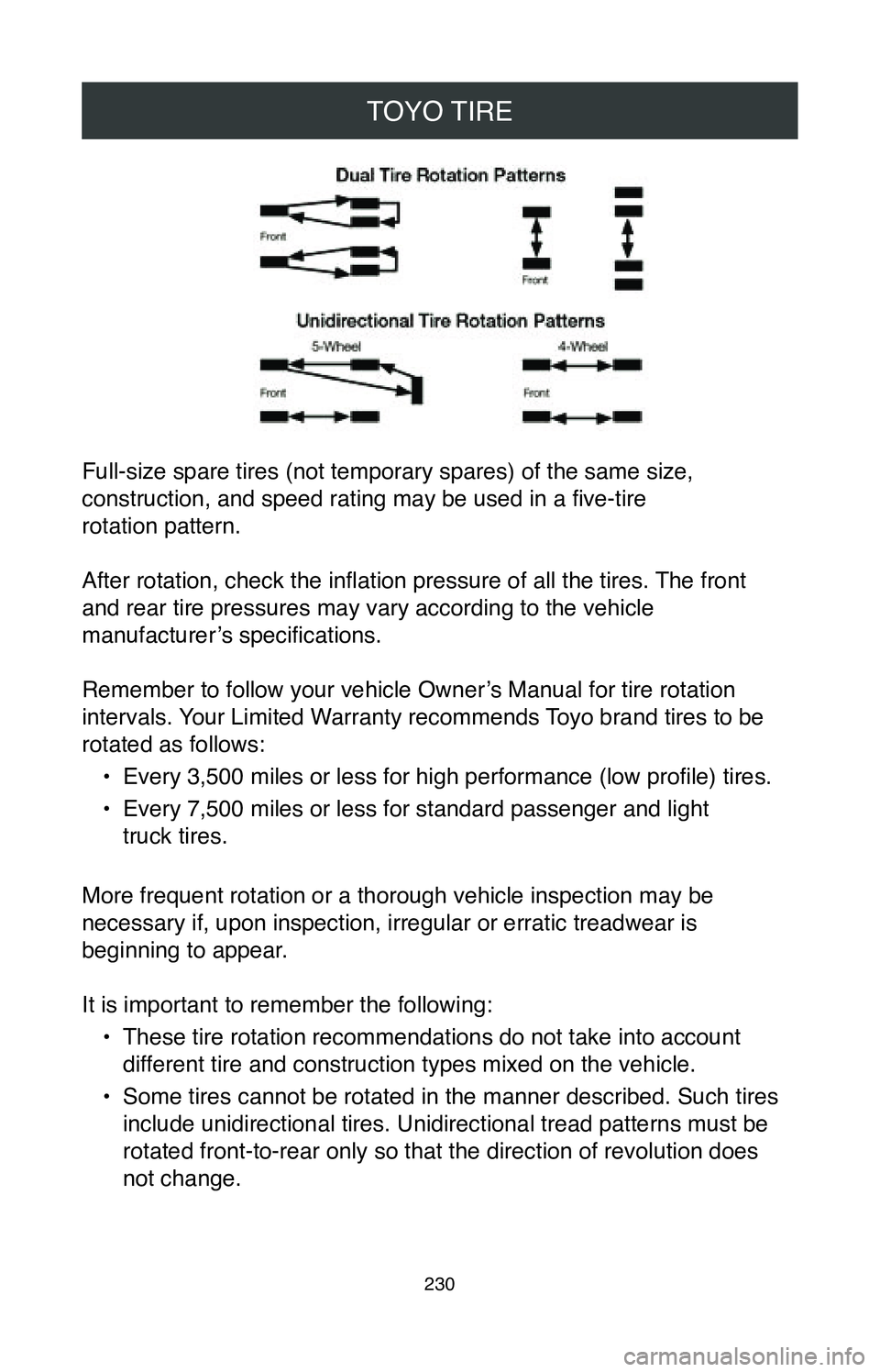
TOYO TIRE
230
Full-size spare tires (not temporary spares) of the same size,
construction, and speed rating may be used in a five-tire
rotation pattern.
After rotation, check the inflation pressure of all the tires. The front
and rear tire pressures may vary according to the vehicle
manufacturer’s specifications.
Remember to follow your vehicle Owner’s Manual for tire rotation
intervals. Your Limited Warranty recommends Toyo brand tires to be
rotated as follows:
•
Every 3,500 miles or less for high performance (low profile) tires.
•
Every 7,500 miles or less for standard passenger and light
truck tires.
More frequent rotation or a thorough vehicle inspection may be
necessary if, upon inspection, irregular or erratic treadwear is
beginning to appear.
It is important to remember the following: •
These tire rotation recommendations do not take into account
different tire and construction types mixed on the vehicle.
•
Some tires cannot be rotated in the manner described. Such tires
include unidirectional tires. Unidirectional tread patterns must be
rotated front-to-rear only so that the direction of revolution does
not change.
Page 233 of 260
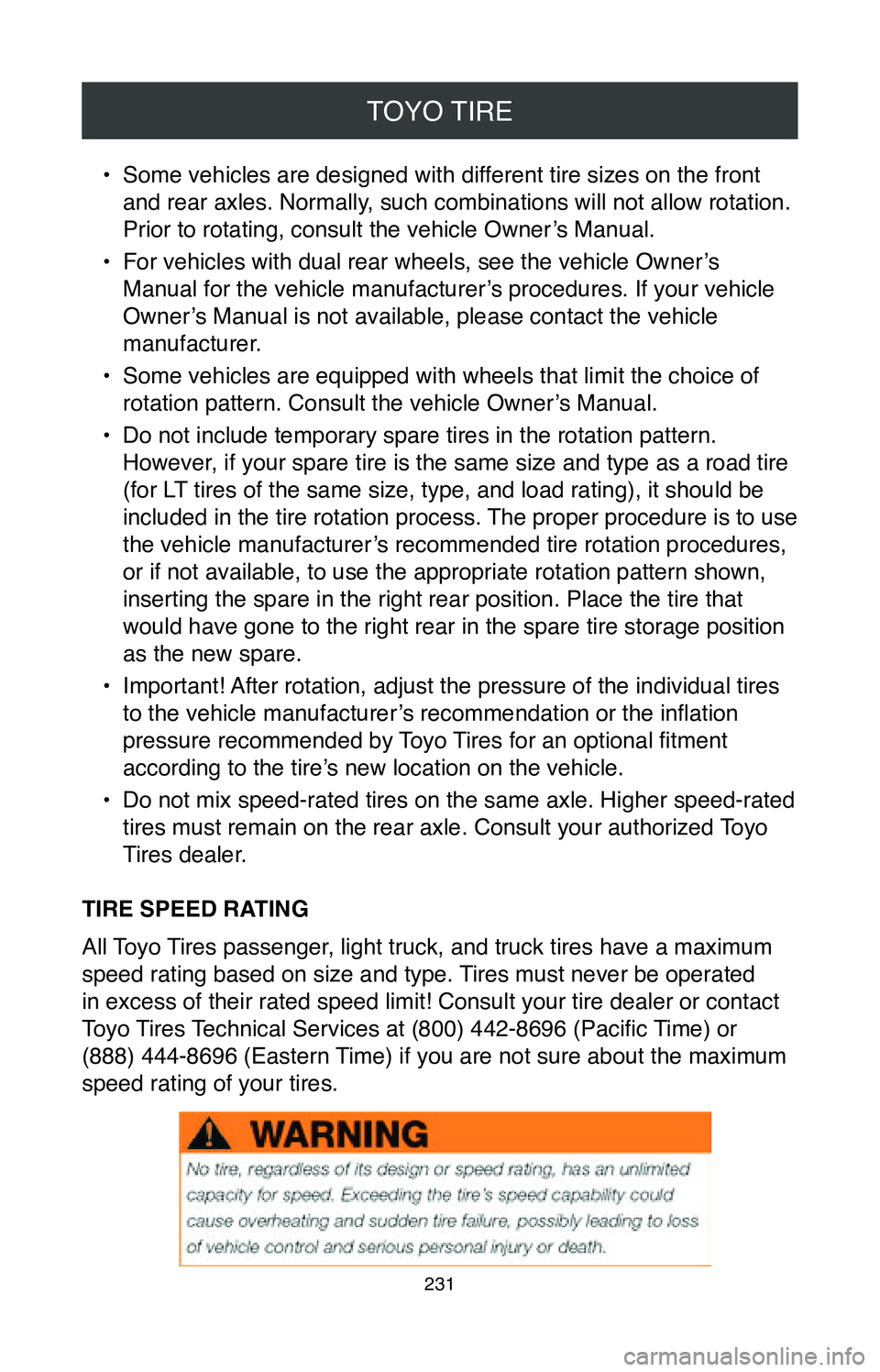
TOYO TIRE
231
• Some vehicles are designed with different tire sizes on the front
and rear axles. Normally, such combinations will not allow rotation.
Prior to rotating, consult the vehicle Owner’s Manual.
•
For vehicles with dual rear wheels, see the vehicle Owner’s
Manual for the vehicle manufacturer’s procedures. If your vehicle
Owner’s Manual is not available, please contact the vehicle
manufacturer.
•
Some vehicles are equipped with wheels that limit the choice of
rotation pattern. Consult the vehicle Owner’s Manual.
•
Do not include temporary spare tires in the rotation pattern.
However, if your spare tire is the same size and type as a road tire
(for LT tires of the same size, type, and load rating), it should be
included in the tire rotation process. The proper procedure is to use
the vehicle manufacturer’s recommended tire rotation procedures,
or if not available, to use the appropriate rotation pattern shown,
inserting the spare in the right rear position. Place the tire that
would have gone to the right rear in the spare tire storage position
as the new spare.
•
Important! After rotation, adjust the pressure of the individual tires
to the vehicle manufacturer’s recommendation or the inflation
pressure recommended by Toyo Tires for an optional fitment
according to the tire’s new location on the vehicle.
•
Do not mix speed-rated tires on the same axle. Higher speed-rated
tires must remain on the rear axle. Consult your authorized Toyo
Tires dealer.
TIRE SPEED RATING
All Toyo Tires passenger, light truck, and truck tires have a maximum
speed rating based on size and type. Tires must never be operated
in excess of their rated speed limit! Consult your tire dealer or contac\
t
Toyo Tires Technical Services at (800) 442-8696 (Pacific Time) or
(888) 444-8696 (Eastern Time) if you are not sure about the maximum
speed rating of your tires.
Page 234 of 260
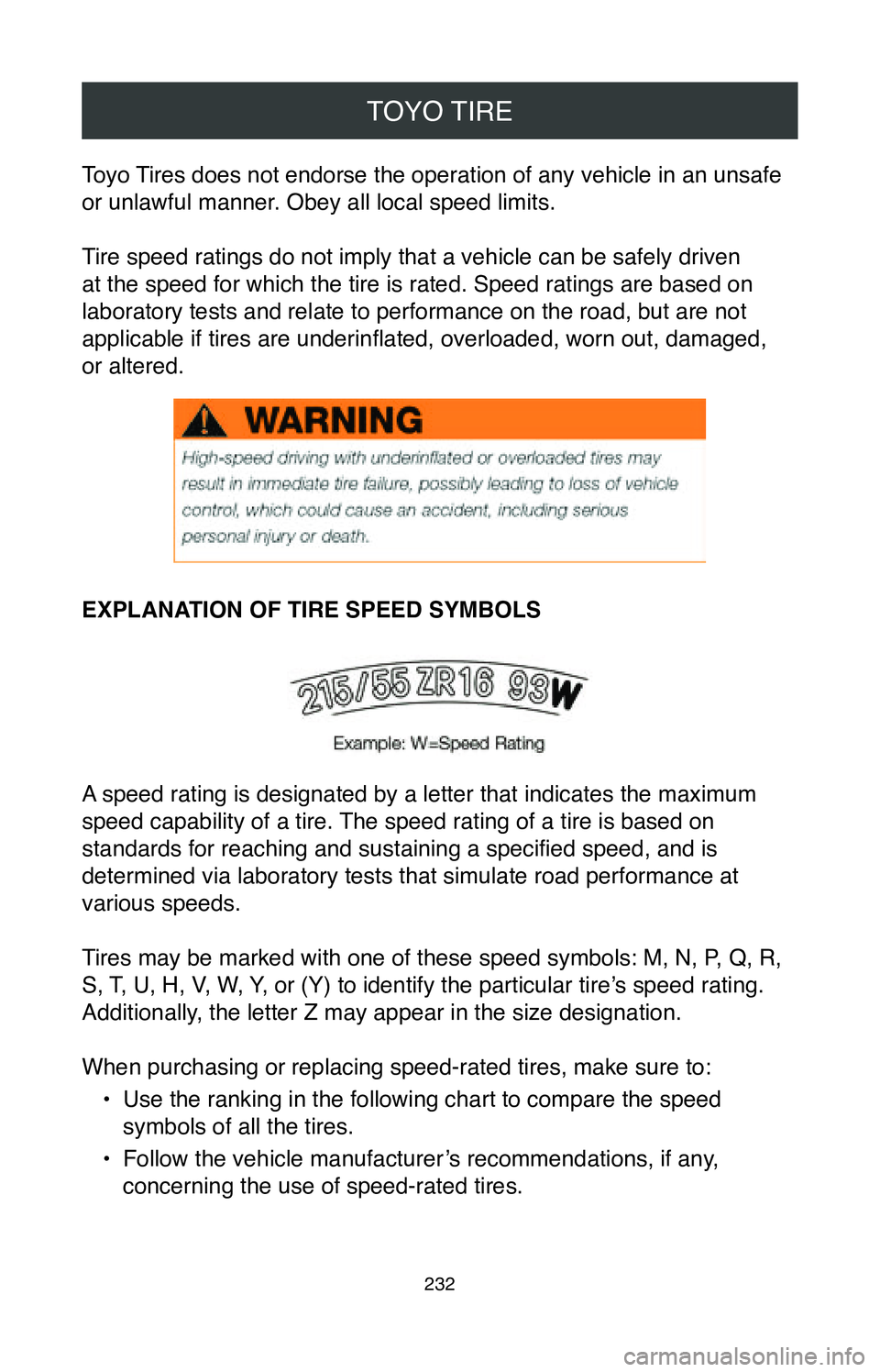
TOYO TIRE
232
Toyo Tires does not endorse the operation of any vehicle in an unsafe
or unlawful manner. Obey all local speed limits.
Tire speed ratings do not imply that a vehicle can be safely driven
at the speed for which the tire is rated. Speed ratings are based on
laboratory tests and relate to performance on the road, but are not
applicable if tires are underinflated, overloaded, worn out, damaged,
or altered.
EXPLANATION OF TIRE SPEED SYMBOLS
A speed rating is designated by a letter that indicates the maximum
speed capability of a tire. The speed rating of a tire is based on
standards for reaching and sustaining a specified speed, and is
determined via laboratory tests that simulate road performance at
various speeds.
Tires may be marked with one of these speed symbols: M, N, P, Q, R,
S, T, U, H, V, W, Y, or (Y) to identify the particular tire’s speed rating.
Additionally, the letter Z may appear in the size designation.
When purchasing or replacing speed-rated tires, make sure to:
•
Use the ranking in the following chart to compare the speed
symbols of all the tires.
•
Follow the vehicle manufacturer’s recommendations, if any,
concerning the use of speed-rated tires.
Page 240 of 260
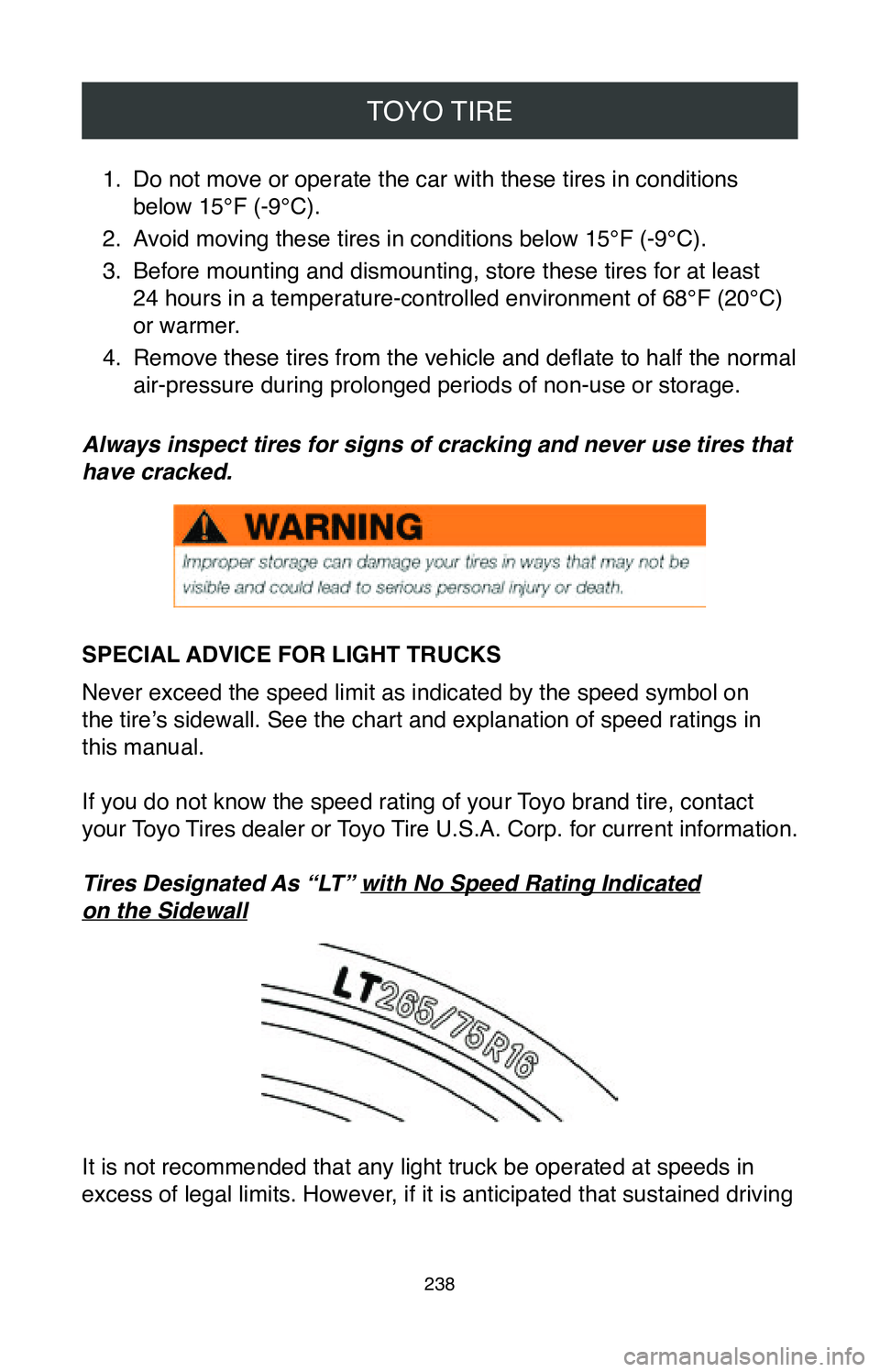
TOYO TIRE
238
1. Do not move or operate the car with these tires in conditions
below 15°F (-9°C).
2.
Avoid moving these tires in conditions below 15°F (-9°C).
3.
Before mounting and dismounting, store these tires for at least
24 hours in a temperature-controlled environment of 68°F (20°C)
or warmer.
4.
Remove these tires from the vehicle and deflate to half the normal
air-pressure during prolonged periods of non-use or storage.
Always inspect tires for signs of cracking and never use tires that
have cracked.
SPECIAL ADVICE FOR LIGHT TRUCKS
Never exceed the speed limit as indicated by the speed symbol on
the tire’s sidewall. See the chart and explanation of speed ratings in
this manual.
If you do not know the speed rating of your Toyo brand tire, contact
your Toyo Tires dealer or Toyo Tire U.S.A. Corp. for current information.
Tires Designated As “LT” with No Speed Rating Indicated
on the Sidewall
It is not recommended that any light truck be operated at speeds in
excess of legal limits. However, if it is anticipated that sustained driving
Page 241 of 260
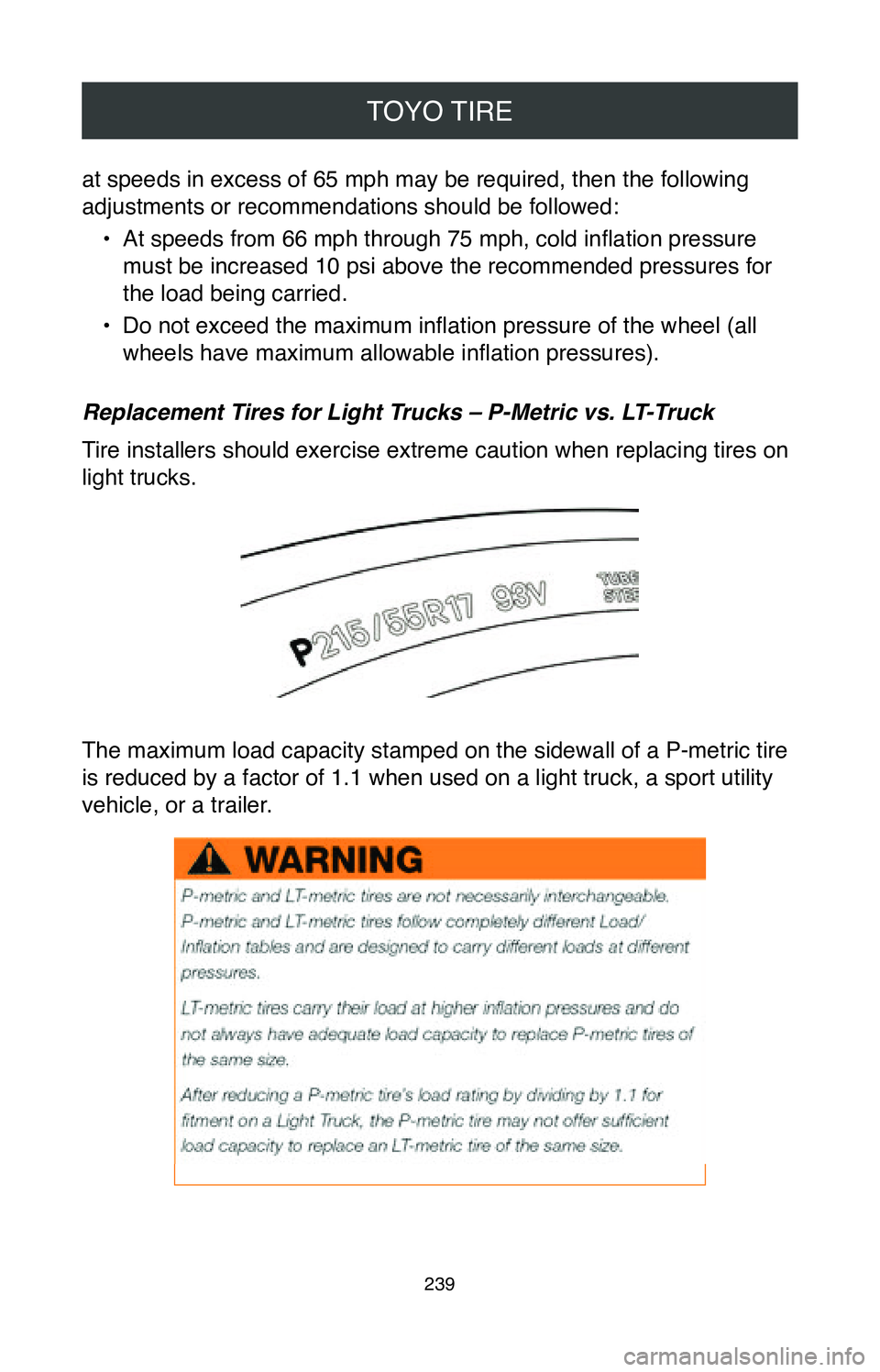
TOYO TIRE
239
at speeds in excess of 65 mph may be required, then the following
adjustments or recommendations should be followed:•
At speeds from 66 mph through 75 mph, cold inflation pressure
must be increased 10 psi above the recommended pressures for
the load being carried.
•
Do not exceed the maximum inflation pressure of the wheel (all
wheels have maximum allowable inflation pressures).
Replacement Tires for Light Trucks – P-Metric vs. LT-Truck
Tire installers should exercise extreme caution when replacing tires on
light trucks.
The maximum load capacity stamped on the sidewall of a P-metric tire
is reduced by a factor of 1.1 when used on a light truck, a sport utilit\
y
vehicle, or a trailer.
Page 242 of 260
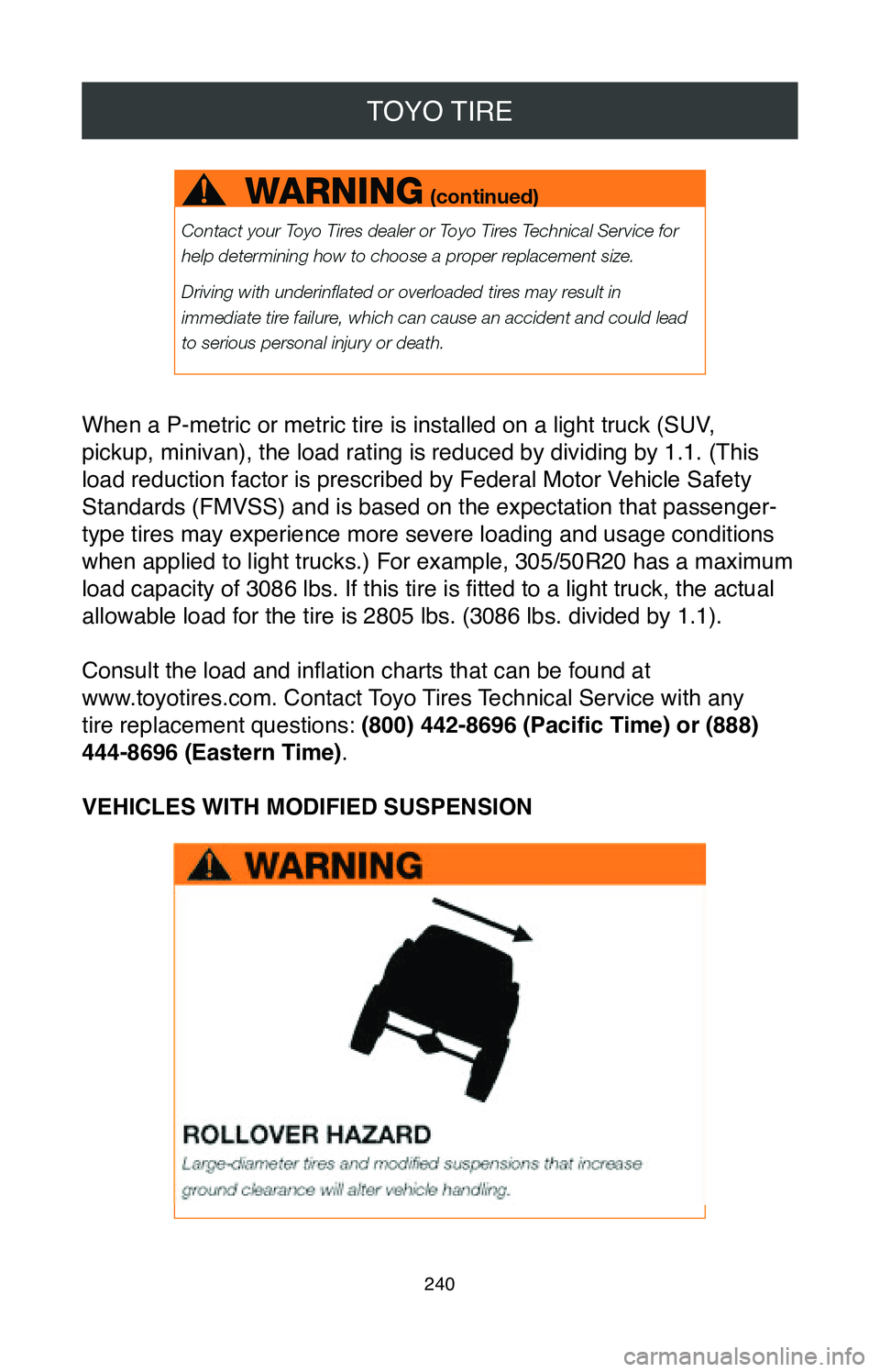
TOYO TIRE
240
When a P-metric or metric tire is installed on a light truck (SUV,
pickup, minivan), the load rating is reduced by dividing by 1.1. (This
load reduction factor is prescribed by Federal Motor Vehicle Safety
Standards (FMVSS) and is based on the expectation that passenger-
type tires may experience more severe loading and usage conditions
when applied to light trucks.) For example, 305/50R20 has a maximum
load capacity of 3086 lbs. If this tire is fitted to a light truck, the actual
allowable load for the tire is 2805 lbs. (3086 lbs. divided by 1.1).
Consult the load and inflation charts that can be found at
www.toyotires.com. Contact Toyo Tires Technical Service with any
tire replacement questions: (800) 442
-8696 (Pacific Time) or (888)
444
-8696 (Eastern Time).
VEHICLES WITH MODIFIED SUSPENSION
Page 243 of 260
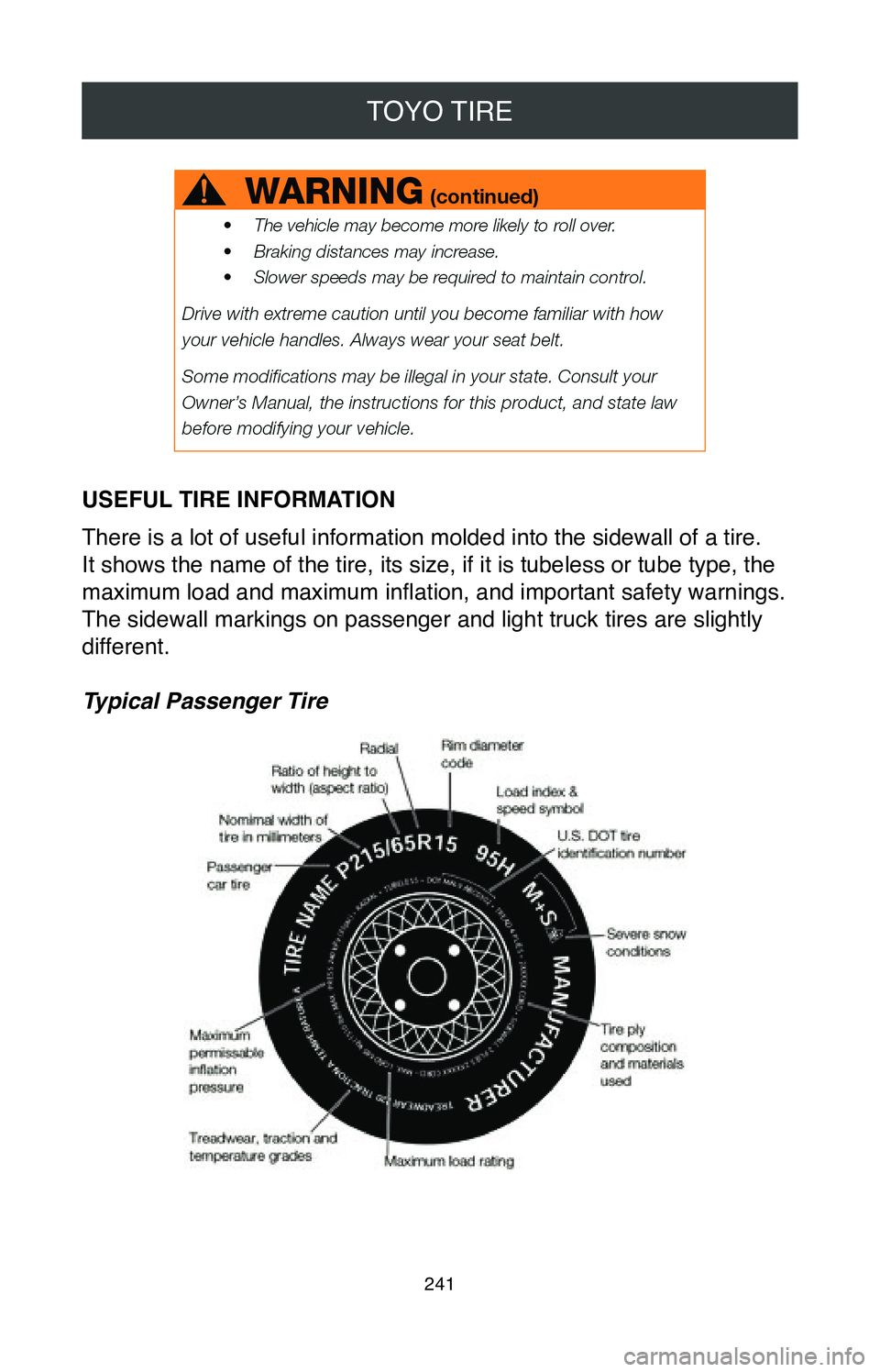
TOYO TIRE
241
USEFUL TIRE INFORMATION
There is a lot of useful information molded into the sidewall of a tire.\
It shows the name of the tire, its size, if it is tubeless or tube type,\
the
maximum load and maximum inflation, and important safety warnings.
The sidewall markings on passenger and light truck tires are slightly
different.
Typical Passenger Tire
Page 249 of 260
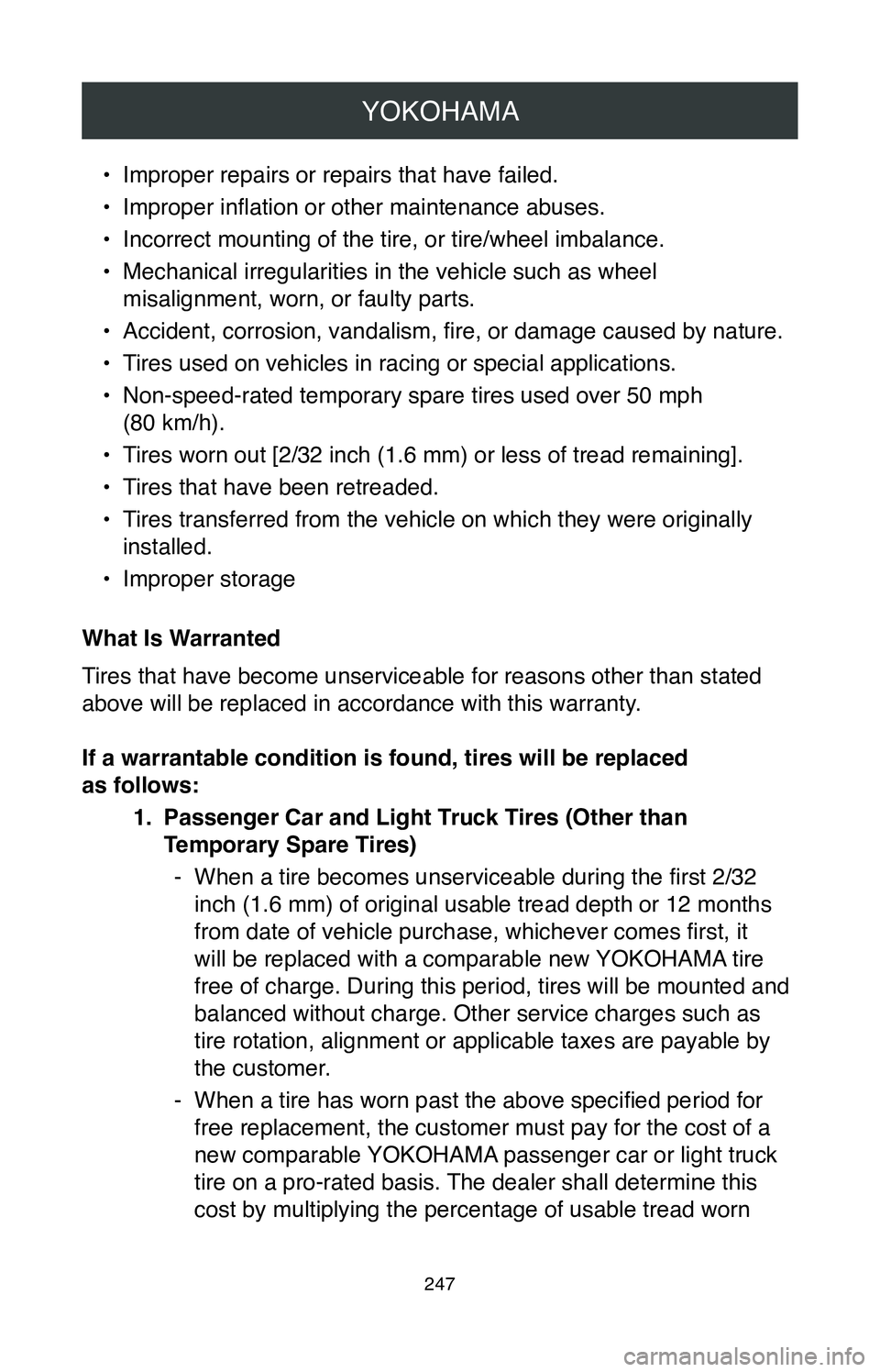
YOKOHAMA
247
• Improper repairs or repairs that have failed.
•
Improper inflation or other maintenance abuses.
•
Incorrect mounting of the tire, or tire/wheel imbalance.
•
Mechanical irregularities in the vehicle such as wheel
misalignment, worn, or faulty parts.
•
Accident, corrosion, vandalism, fire, or damage caused by nature.
•
Tires used on vehicles in racing or special applications.
•
Non-speed-rated temporary spare tires used over 50 mph
(80 km/h).
•
Tires worn out [2/32 inch (1.6 mm) or less of tread remaining].
•
Tires that have been retreaded.
•
Tires transferred from the vehicle on which they were originally
installed.
•
Improper storage
What Is Warranted
Tires that have become unserviceable for reasons other than stated
above will be replaced in accordance with this warranty.
If a warrantable condition is found, tires will be replaced
as follows: 1.
Passenger Car and Light Truck Tires (Other than
Temporary Spare Tires)
- When a tire becomes unserviceable during the first 2/32 inch (1.6 mm) of original usable tread depth or 12 months
from date of vehicle purchase, whichever comes first, it
will be replaced with a comparable new YOKOHAMA tire
free of charge. During this period, tires will be mounted and
balanced without charge. Other service charges such as
tire rotation, alignment or applicable taxes are payable by
the customer.
- When a tire has worn past the above specified period for free replacement, the customer must pay for the cost of a
new comparable YOKOHAMA passenger car or light truck
tire on a pro-rated basis. The dealer shall determine this
cost by multiplying the percentage of usable tread worn
Page 252 of 260
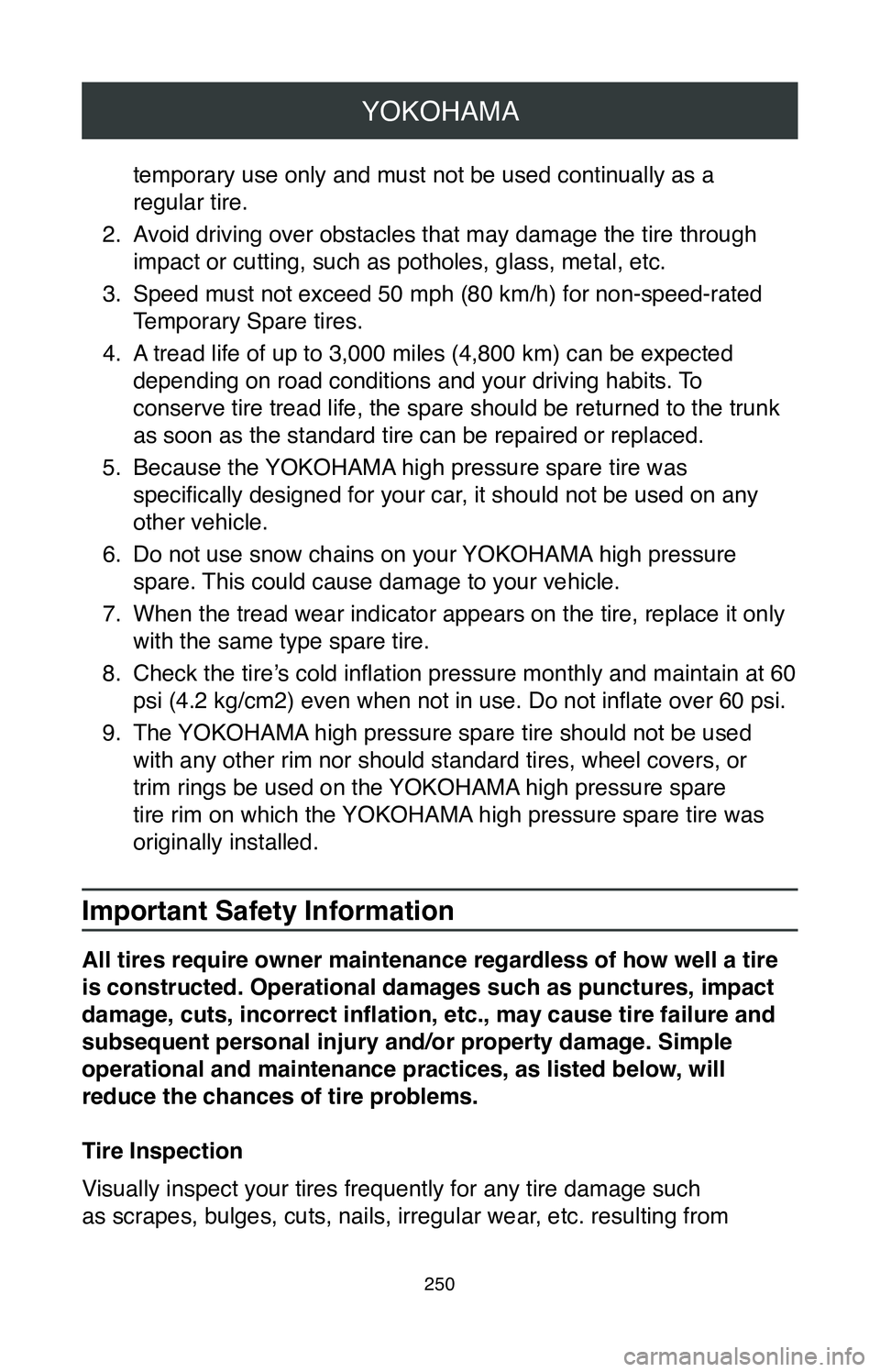
YOKOHAMA
250
temporary use only and must not be used continually as a
regular tire.
2.
Avoid driving over obstacles that may damage the tire through
impact or cutting, such as potholes, glass, metal, etc.
3.
Speed must not exceed 50 mph (80 km/h) for non-speed-rated
Temporary Spare tires.
4.
A tread life of up to 3,000 miles (4,800 km) can be expected
depending on road conditions and your driving habits. To
conserve tire tread life, the spare should be returned to the trunk
as soon as the standard tire can be repaired or replaced.
5.
Because the YOKOHAMA high pressure spare tire was
specifically designed for your car, it should not be used on any
other vehicle.
6.
Do not use snow chains on your YOKOHAMA high pressure
spare. This could cause damage to your vehicle.
7.
When the tread wear indicator appears on the tire, replace it only
with the same type spare tire.
8.
Check the tire’s cold inflation pressure monthly and maintain at 60
psi (4.2 kg/cm2) even when not in use. Do not inflate over 60 psi.
9.
The YOKOHAMA high pressure spare tire should not be used
with any other rim nor should standard tires, wheel covers, or
trim rings be used on the YOKOHAMA high pressure spare
tire rim on which the YOKOHAMA high pressure spare tire was
originally installed.
Important Safety Information
All tires require owner maintenance regardless of how well a tire
is constructed. Operational damages such as punctures, impact
damage, cuts, incorrect inflation, etc., may cause tire failure and
subsequent personal injury and/or property damage. Simple
operational and maintenance practices, as listed below, will
reduce the chances of tire problems.
Tire Inspection
Visually inspect your tires frequently for any tire damage such
as scrapes, bulges, cuts, nails, irregular wear, etc. resulting from
Page 253 of 260
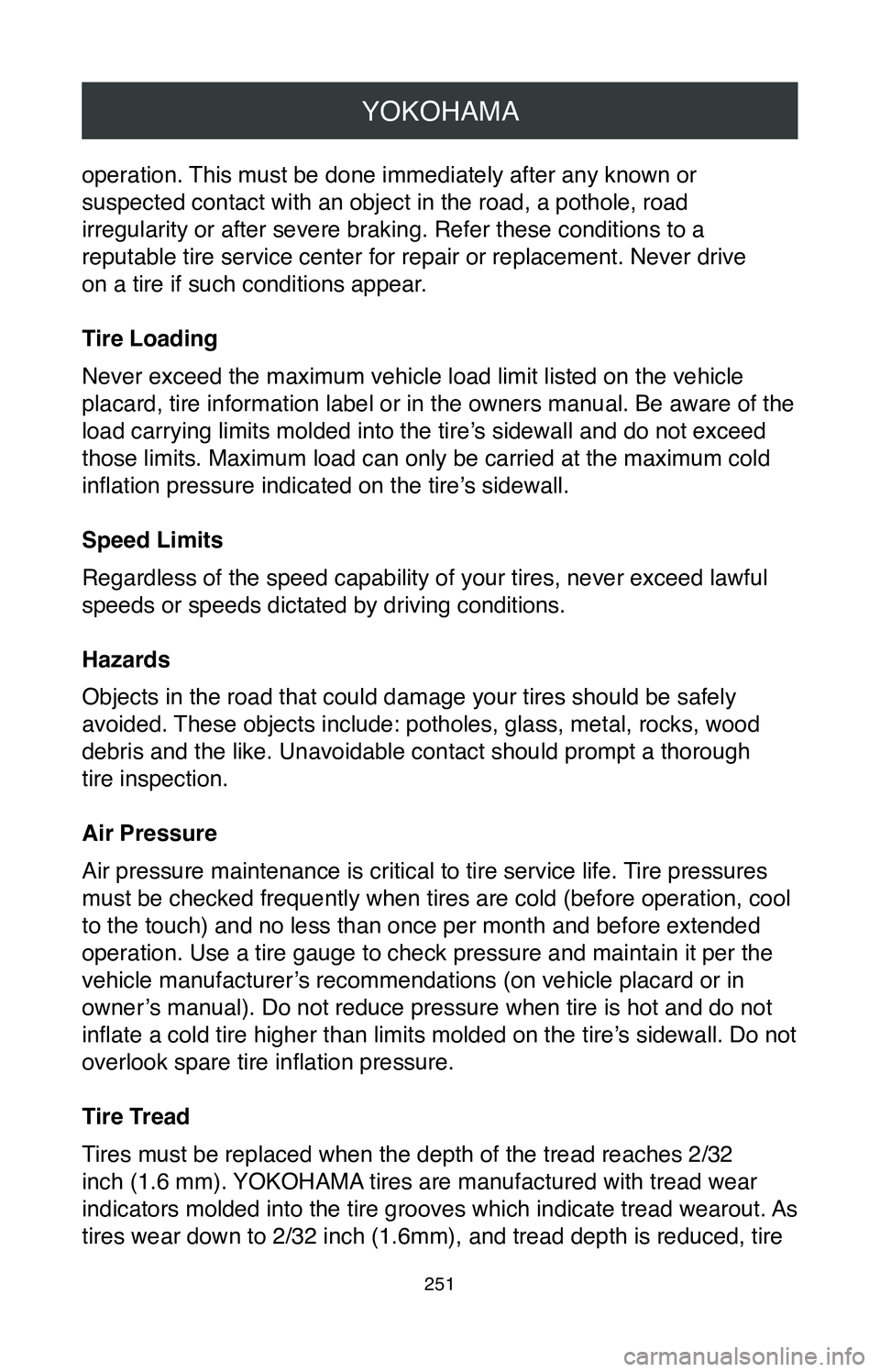
YOKOHAMA
251
operation. This must be done immediately after any known or
suspected contact with an object in the road, a pothole, road
irregularity or after severe braking. Refer these conditions to a
reputable tire service center for repair or replacement. Never drive
on a tire if such conditions appear.
Tire Loading
Never exceed the maximum vehicle load limit listed on the vehicle
placard, tire information label or in the owners manual. Be aware of the\
load carrying limits molded into the tire’s sidewall and do not exceed
those limits. Maximum load can only be carried at the maximum cold
inflation pressure indicated on the tire’s sidewall.
Speed Limits
Regardless of the speed capability of your tires, never exceed lawful
speeds or speeds dictated by driving conditions.
Hazards
Objects in the road that could damage your tires should be safely
avoided. These objects include: potholes, glass, metal, rocks, wood
debris and the like. Unavoidable contact should prompt a thorough
tire inspection.
Air Pressure
Air pressure maintenance is critical to tire service life. Tire pressures
must be checked frequently when tires are cold (before operation, cool
to the touch) and no less than once per month and before extended
operation. Use a tire gauge to check pressure and maintain it per the
vehicle manufacturer’s recommendations (on vehicle placard or in
owner’s manual). Do not reduce pressure when tire is hot and do not
inflate a cold tire higher than limits molded on the tire’s sidewall. Do not
overlook spare tire inflation pressure.
Tire Tread
Tires must be replaced when the depth of the tread reaches 2/32
inch (1.6 mm). YOKOHAMA tires are manufactured with tread wear
indicators molded into the tire grooves which indicate tread wearout. As
tires wear down to 2/32 inch (1.6mm), and tread depth is reduced, tire